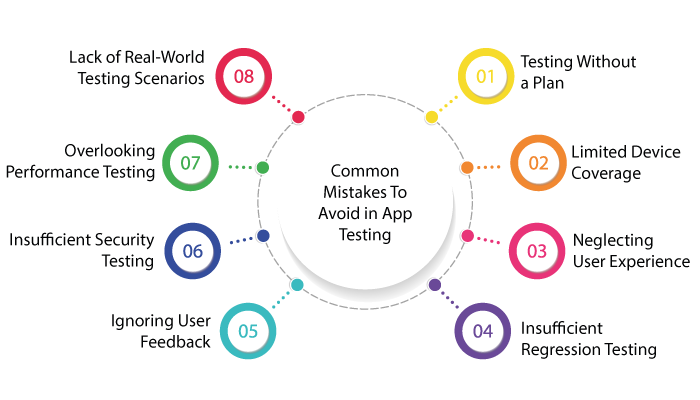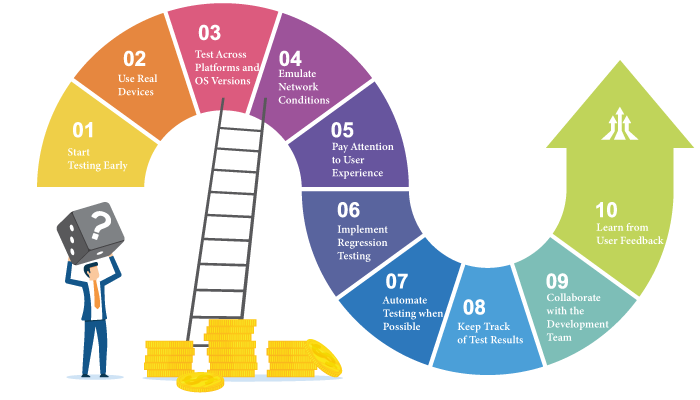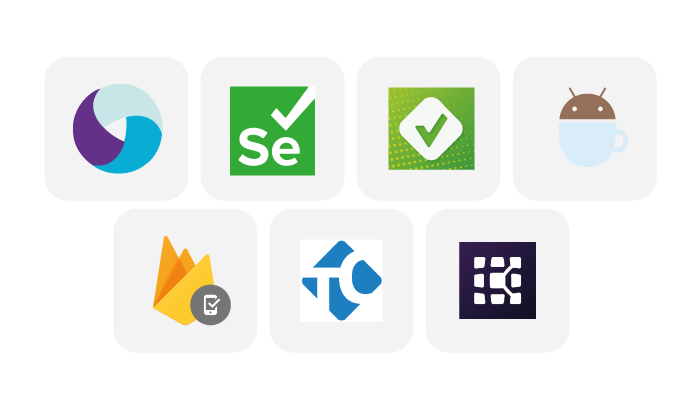Table of Contents
Interested in mobile app testing?
You might be surprised to know that a staggering 80% of customers delete or uninstall an app that doesn’t meet their expectations.
Yes, that’s right! Your app needs to impress and engage users from the get-go, or they’ll bid it farewell faster than you can say “uninstall.”
But that’s not all.
Did you know that around 50% of customers tend to uninstall an app that takes up too much space on their precious devices?
It’s like a virtual game of “Tetris” where users are trying to free up space for the apps that matter the most to them. So, optimizing your app’s size is crucial to keeping it on their screens.
Oh, and let’s not forget about speed! A whopping 48% of customers uninstall or abandon an app if it’s slow.
Picture this: users tap on your app icon with anticipation, only to be met with loading screens that feel like an eternity. It’s like waiting in a never-ending queue at the amusement park. Frustration sets in, and poof! Off goes your app, uninstalled in a blink of an eye.
So, how can you avoid these pitfalls and ensure your app stays in the hearts (and devices) of your users? That’s where mobile app testing comes to the rescue! Testing your app thoroughly before releasing it into the wild is like donning a superhero cape and protecting it from potential disasters.
Moving on, if you want to learn more about this concept, read this blog till the end, we shall be discussing all you need to know about it. Therefore, let’s get right into it:
Introduction To Mobile App Testing

Let’s break it down.
Mobile app testing is the process of checking and evaluating mobile applications to ensure they work properly and provide a great user experience. It’s like giving the app a thorough examination to find any issues or bugs before it reaches the hands of users.
Testing a mobile app involves different steps and techniques. Testers use various devices (like smartphones and tablets) and software tools to simulate real-world scenarios and interactions. They go through the app’s features, screens, and functions to make sure everything works as intended. And this makes testing an essential part of mobile app development.
The goal of mobile app testing is to identify and fix any problems, such as crashes, slow performance, broken links, or incorrect data display. Testers also check if the app is compatible with different operating systems, screen sizes, and device configurations.
Why is Mobile App Testing Important?

Mobile app testing plays a vital role in delivering high-quality and reliable mobile applications.
By conducting thorough testing, app developers can identify and rectify issues early in the development cycle, enhancing the overall user experience and increasing customer satisfaction.
Moving on there are several other reasons as to why mobile app testing is so important. Let’s discuss the m below:
Ensuring a Great User Experience
App Testing helps ensure that users have a positive and seamless experience when using the mobile app. By identifying and fixing bugs, crashes, and usability issues, testers make sure the app works as intended, resulting in happier users.
Maintaining App Reliability
Nobody likes a buggy app that crashes or freezes frequently. Testing helps identify and resolve issues that may affect the app’s reliability. By catching and fixing these problems before release, testers help maintain the app’s reputation and trustworthiness.
Enhancing Performance
Performance issues, such as slow loading times or laggy responses, can frustrate users and lead to app abandonment. Through performance testing, testers identify bottlenecks and optimize the app’s speed and responsiveness, ensuring a smooth user experience.
Compatibility with Different Device
With a wide variety of mobile devices, operating systems, and screen sizes available, it’s crucial to ensure that the app works seamlessly across various configurations. App Testing helps identify compatibility issues and ensures the app functions correctly on different devices and platforms.
Security and Data Protection
Mobile apps often handle sensitive user data, making security testing essential. Testers check for vulnerabilities and ensure that proper measures are in place to protect user information from potential threats and attacks.
Saving Time and Resources
While app testing may seem like an additional step in the development process, it ultimately saves time and resources in the long run. Identifying and resolving issues early on prevents costly fixes and negative user experiences post-release.
Maintaining App Store Guidelines
App stores have specific guidelines and standards that must be met for an app to be approved and listed. Testing helps ensure that the app complies with these guidelines, reducing the chances of rejection or removal from the app store.
Now that we know of the importance of app testing, it’s time to discuss the different types of mobile app testing that you might come across in the section below:
Types of App Testing

Functional Testing
You know that app features need to work properly, right? Functional testing checks if buttons, menus, and other interactive elements do what they’re supposed to do. It’s like making sure everything runs smoothly, so you can enjoy a hassle-free experience.
Usability Testing
Have you ever used an app that confused or frustrated you? Usability testing focuses on the user experience, ensuring the app is easy to navigate and interact with. Testers pretend to be users, trying different tasks to see if everything flows naturally and makes sense.
Performance Testing
Nobody likes a slow app, right? Performance testing checks how well the app performs under different conditions. Testers measure things like response time, load capacity, and stability to make sure the app stays fast, reliable, and responsive, no matter what.
Compatibility Testing
With so many different devices out there, it’s important to ensure the app works on all of them. Compatibility testing ensures the app functions correctly across various screen sizes, operating systems, and device configurations. It’s like making sure the app fits perfectly on any device you use.
Security Testing
We all want our data to be safe, right? Security testing helps identify vulnerabilities and ensures the app protects user information from unauthorized access or malicious activities. Testers play the role of “digital detectives” to make sure your personal data is secure within the app.
Localization Testing
Imagine using an app that’s not properly translated or localized for your region. Localization testing checks if the app is adapted for different languages and cultural expectations. Testers verify that text, dates, currencies, and other localized elements appear correctly for your specific audience.
Regression Testing
When an app undergoes updates or fixes, it’s important to check that everything still works as intended. Regression testing retests previously tested functionalities to catch any new issues that might have popped up. It’s like a double-check to maintain the app’s overall functionality and stability.
Accessibility Testing
Apps should be accessible to everyone, including people with disabilities. Accessibility testing ensures the app supports assistive technologies and provides an inclusive experience. Testers ensure that people with visual impairments or motor disabilities can use the app without any difficulties.
Mobile App Testing Process

Wondering how mobile app development companies test the mobile apps they develop? Well, wonder no more because we shall be discussing the mobile app testing process in detail.
Therefore, with this being said, let’s get right into it:
1. App Test Planning
You’re about to embark on a testing adventure! It all starts with creating a plan. You’ll strategize and decide how to test the app based on its goals and audience. Think of it as mapping out your journey before setting off.
2. Test Environment Setup
Imagine preparing your testing space. You’ll gather the devices, operating systems, and tools needed to conduct your tests. It’s like setting up your own testing headquarters, ensuring you have everything you need at your fingertips.
3. App Test Case Design
Now it’s time to create your testing scenarios. You’ll develop test cases, which are like step-by-step instructions to check different aspects of the app. It’s like having a detective’s checklist to investigate and catch any issues that come your way.
4. Test Execution
This is where the real action begins! You’ll run your test cases and interact with the app as if you were a user. You’ll click buttons, fill in forms, and navigate through screens, checking for any unexpected behaviors or bugs.
5. Defect Reporting
If you find any issues during testing, it’s important to report them. You’ll document the defects you encounter, providing detailed information about what went wrong. Think of it as creating a bug report to help developers understand and fix the problems.
6. Defect Verification and Retesting
Once the developers have fixed the reported issues, you’ll verify if the fixes actually resolved the problems. It’s like giving the app a second chance to prove itself. If everything looks good, you’ll move on to retesting to ensure no new issues were introduced.
7. App Test Completion and Reporting
Congratulations! You’ve reached the end of your testing journey. You’ll compile all your test results, summarize your findings, and prepare a test report. It’s like wrapping up your adventure and presenting your discoveries to the development team.
Now that we are done with the app testing process, it’s time to look at some of the common mistakes that one should avoid while doing so in next section of the blog.
Common Mistakes To Avoid in App Testing

Making mistake is easy. However, you can learn from others mistakes. Therefore, we shall be discussing some of the common mistake that you should avoid in mobile app testing. These are, as mentioned below:
Testing Without a Plan
Imagine going on a journey without a map or a plan. It can lead to confusion and wasted effort. Similarly, avoid jumping into testing without a clear strategy and test plan. Take the time to outline your testing objectives and create a roadmap to follow.
Limited Device Coverage
Testing on only a few devices can limit your understanding of how the app performs across different platforms and screen sizes. Expand your device coverage to ensure compatibility and to reach a broader audience.
Neglecting User Experience
You’re testing an app that real users will use, so it’s crucial to prioritize the user experience. Don’t just focus on functional aspects; pay attention to usability, intuitive navigation, and overall satisfaction. Put yourself in the shoes of the users and think about what would make their experience delightful.
Insufficient Regression Testing
When new features or fixes are implemented, it’s essential to retest previously tested areas of the app. Neglecting regression testing can lead to the reappearance of old issues or the introduction of new ones. Don’t skip this step to maintain the overall stability and functionality of the app.
Lack of Real-World Testing Scenarios
Testing in an isolated environment may not accurately represent real-world usage. Consider using real-world scenarios to simulate user behavior and test the app under different conditions, such as poor network connectivity or low battery.
Overlooking Performance Testing
Performance issues, such as slow loading times or app crashes, can frustrate users and impact their experience. Don’t forget to include performance testing to identify bottlenecks, optimize speed, and ensure the app remains responsive and efficient.
Insufficient Security Testing
Your users trust you with their personal data, so it’s crucial to prioritize security testing. Identify potential vulnerabilities, validate authentication mechanisms, and protect sensitive information. By doing so, you’ll enhance the app’s credibility and protect user privacy.
Ignoring User Feedback
User feedback is a valuable resource for identifying potential issues and improving the app. Don’t dismiss user reports or reviews. Actively listen to your users, address their concerns, and continuously iterate based on their feedback
By avoiding the mistakes we discussed above, you can save your app from getting rejected by App Store or even worse, fall down in market.
Speaking of which, know that you know what not to do, it’s time to discuss things that you should do.
Mobile App Testing Best Practices

In this section of the blog, we shall be discussing some mobile app testing best practices that you should follow at all costs.
Therefore, with this being said, let’s get right into it:
Start Testing Early
You’re in for success when you begin testing your app as early as possible in the development process. By catching issues early on, you can save time and effort in the long run.
Use Real Devices
Imagine testing your app on actual devices instead of just relying on emulators or simulators. Real devices give you accurate results and help you understand how the app performs in real-world situations.
Test Across Platforms and OS Versions
Your app needs to shine on different platforms and operating system versions. Ensure compatibility by testing on various platforms like iOS and Android and across different OS versions.
Emulate Network Conditions
Put yourself in different network scenarios. Test the app’s performance under various network conditions, such as slow or unstable connections. This helps ensure your app remains robust and responsive.
Pay Attention to User Experience
Think like a user! Test the app’s usability, navigation, and overall user experience. Make sure it’s intuitive, easy to use, and provides a delightful experience for your users.
Implement Regression Testing
As the app evolves, make sure you don’t break what’s already working. Perform regression testing to check if new updates or fixes introduce any new issues or impact existing functionalities.
Automate Testing when Possible
Automation can be your superhero sidekick in testing. Utilize automation tools to speed up repetitive tests, save time, and increase efficiency. This frees up your time for more critical and exploratory testing.
Keep Track of Test Results
Stay organized! Maintain proper documentation of test results, including any defects or issues encountered. This helps the development team understand and address the problems efficiently.
Collaborate with the Development Team
Testing and development go hand in hand. Maintain open communication and collaborate closely with the development team. Share feedback, report issues promptly, and work together to improve the app’s quality.
Learn from User Feedback
Your users are the best source of insight. Listen to their feedback, reviews, and suggestions. Incorporate their insights into your testing efforts to make informed improvements.
Mobile App Testing Tools

Lastly, let’s go through some mobile app testing tools that can help you automate testing process and reap better results.
So, without furtherado, let’s get right into it:
· Appium
Appium is an open-source tool for mobile app automation testing. It supports both iOS and Android platforms and allows testers to write automated tests using popular programming languages such as Java, Python, or Ruby.
· Selenium
Selenium is primarily known as a web testing tool but can also be used for mobile app testing through integration with frameworks like Appium. It provides a range of features for automating mobile app tests, including cross-platform support and compatibility with multiple programming languages.
· XCUITest
XCUITest is an automation framework provided by Apple for testing iOS apps. It allows testers to write UI tests for iOS apps using Swift or Objective-C programming languages. XCUITest offers extensive support for interacting with native iOS elements.
· Espresso
Espresso is a widely-used testing framework for Android app testing. It provides a robust and concise API for writing UI tests in Java or Kotlin. Espresso supports both functional testing and UI automation and offers synchronization capabilities for handling asynchronous operations.
· Firebase Test Lab
Firebase Test Lab, part of Google Firebase, offers a cloud-based testing platform for mobile apps. It provides a variety of testing options, including compatibility testing, performance testing, and automated UI testing. Firebase Test Lab supports both Android and iOS platforms.
· TestComplete
TestComplete is a comprehensive testing tool that supports testing mobile apps, web applications, and desktop applications. It offers cross-platform testing capabilities and supports scripting in multiple programming languages, including JavaScript, VBScript, and Python.
· Kobiton
Kobiton is a cloud-based mobile testing platform that allows testers to perform manual and automated testing on real devices. It offers features such as device management, test automation, and integration with popular testing frameworks like Appium and Selenium.
Conclusion
App testing plays an important role in determining whether or not an app is going to be successful. Now, there are various things that goes into app testing as we discussed in the blog. And it can be very typical at times for various reasons. In any case, we discussed all you need to know about the same in this blog and with this we conclude it.
FAQ
Mobile app testing is crucial to identify and fix bugs, ensure compatibility across devices and platforms, optimize user experience, and enhance app performance, ultimately leading to higher user satisfaction and app success.
Common challenges in mobile app testing include device fragmentation, varying screen sizes, OS versions, network conditions, limited resources for testing, and the need to cover both functional and non-functional aspects of the app.
Different types of mobile app testing include functional testing, performance testing, compatibility testing, usability testing, security testing, localization testing, and regression testing.
To ensure compatibility, test your app on a wide range of devices, covering various screen sizes, resolutions, and OS versions. Use emulators, simulators, and real devices to validate functionality, UI, and performance across the target audience’s devices.
Testing should start early in the development process, ideally during the design and prototyping stages. Early testing helps identify issues sooner, reducing the cost and effort of fixing them later in the development cycle.
Usability testing helps evaluate how easily users can interact with your app, ensuring a positive user experience. By collecting user feedback and observing their behavior, you can identify usability issues and make necessary improvements.
To enhance the security of your mobile app, perform security testing to identify vulnerabilities. Use encryption for sensitive data, implement secure authentication mechanisms, and regularly update the app to patch any security flaws.
Automation plays a crucial role in mobile app testing by reducing manual effort, improving test coverage, and accelerating the testing process. It helps execute repetitive tests, perform regression testing, and ensures consistent results.





No Comments
Comments are closed.